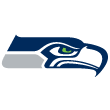
2. CenturyLink Field, Seattle Seahawks
Over the past decade, the Seahawks' home/road winning percentage differential (.646/.373/.273 difference) is the league's third-best.
Packers quarterback Aaron Rodgers might have seen this one coming.
Even before replacement officials wrested victory from the jaws of defeat for the home team, Seattle's CenturyLink Field was already in Rodgers' head.
"Those fans are really intelligent fans," he told reporters before the Week 3 Monday night game. "They get so stinking loud out there. They do a really good job of giving the defense that advantage when we have to go on some silent counts or when we're trying to hear each other. They should be commended for that."
After losing the controversial game 14-12, Rodgers declined to commend the officiating, terming it, succinctly, "awful." While both Seahawks receiver Golden Tate and Packers safety M.D. Jennings appeared to get their hands on Russell Wilson's Hail Mary to end the game, it was ruled a Seattle touchdown. Did the deafening crowd noise play a hand in that decision?
"We practice with sound at practice, and you try to simulate some of that," Rodgers said. "But I think you know when you play at a stadium like Seattle -- Seattle and Kansas City are probably the two loudest outdoor stadiums -- but it's definitely an extra factor and aid for that defense."
Despite the loss, Packers linebacker A.J. Hawk was impressed.
"That place is awesome," he said. "All that energy out there. That's what makes it fun for a player. They seem to have found a way to make it so loud."
The irony? The man most responsible for this wild, frenzied home advantage is a Packers fan.
Yes, architect Jon Niemuth somehow managed the clever trick of making an outdoor stadium as loud as a domed arena. Those were his marching orders from owner Paul Allen when planning began to replace the late, great Kingdome. Allen, who grew up as a University of Washington football fan, wanted the raucous atmosphere of Husky Stadium.
"Paul has such fond memories of Husky Stadium," said Niemuth, design director in charge of sports for AECOM, which has designed many professional sports venues. "Washington's opens up to Union Bay. We came up with a concept in a week -- a front door that opens up into the city. We had a big vertical scoreboard and some funky end zone seating."
During the design phase, Mike Holmgren was brought in from Green Bay to run the franchise.
"His first two questions were: Why is it open-air and why not artificial turf?" Niemuth said. "He thought both of those things neutralized the home-field advantage. I said, 'Mike, go talk to your boss.'"
Seahawks Stadium, featuring its distinctive roof canopies that protect 70 percent of the fans from the inevitable elements, debuted in 2002 and two years later was christened Qwest Field. When Qwest was acquired by CenturyLink, the 67,000-seat stadium had its third name in a decade. Its advantages can be traced to the smallest stadium footprint in the NFL, some 900,000 square feet. The upper levels are cantilevered over the lower ones so fans are literally stacked tightly on top of each other.
It doesn't seem to make sense, but the open northern end with its aluminum grandstand is louder than the closed southern end.
"Everything about that section was designed to be loud," Niemuth said. "The sound is just down and dirty. Originally, it was intended to be no-frills pricing, but it got this great following. Joe Six-Pack loved it. It was this cult-of-personality section that took on a life of its own.
"At Lambeau, the sound goes up and out into the air. Those roof canopies capture sound. When the stadium gets loud, it doesn't leave."
Maybe it's all that caffeine from the local coffee industry. Whatever the reason, Seattle typically leads the league in false-start penalties for opposing offenses. The number over the past decade is a formidable 143, only two fewer than in Minnesota.
There's more, too: Since 2003, the Seahawks have outscored opponents by 430 points at home. On the road, they have been outscored by 361. That differential (791 points) is the league's second-biggest gap, after the Baltimore Ravens.
Seattle also has another major advantage: geography. The closest NFL city is San Francisco, some 678 miles to the south. Consider the travel distance for each of the Seahawks' other NFC West rivals -- the Arizona Cardinals (1,114 miles) and St. Louis Rams (1,719). If you're coming from Miami or Buffalo, good luck with that.
Seattle's longest-tenured veteran is cornerback Marcus Trufant, a first-round draft choice in 2003.
"We call it the 12th man out here," Trufant said. "They're loud and crazy; they just own it. I think it's just the energy they bring to the defense, the push they give the offense."
Then Trufant paused and, perhaps thinking of that recent Green Bay game, added: "They're always in our corner. Sometimes, they even work the referees."
